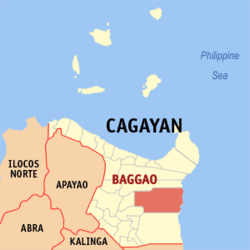History
Long before the issuance of the Royal Decree which officially detached Baggao as a barrio of Amulung on November 27, 1896, the place has already became famous as a hunting ground. It was detached from Amulung to become a separate Spanish mission. [6]
With the formal creation of Baggao as a separate municipality, Rev. Fr. Pedro Vicandi, O.P. who was then the Parish Priest of the area, was designated officer-in-charge of the town. His chapel, and at the same time, the town hall consisted of a shack made of bamboo and cogon built atop of a hill one kilometer southeast of the present municipal building.
On April 18, 1899 Fr. Vicandi fled the area when Col. Daniel Tirona, under Gen. E. Aguinaldo, visited the Town and put to flame the friar’s shanty. However, in September 1899, when civil order was finally restored, Don Rafael Catolico took over as the first mayor of the New “Pueblo Civil”.
For more than 85 years since it was separated from its mother town of Amulung, the seat of the Municipal Government of Baggao has been seated at the Centro or Poblacion. In 1899, when Don Rafael Catolico took over as the first mayor of the new “Pueblo Civil” there were 5,051 inhabitants living in sparse settlements. The communities given the official status as a barrio were those immediately surrounding the Poblacion. Most of the barangays, now established upstream were merely patches of forest clearings barely making the requirements of becoming a full-fledge barrio.
However, with the continuous influx of immigrants from other towns and provinces, new communities sprouted continuously moving further northeastward to the more fertile expanse of this virgin municipality. As of today there are already 48 barangays settled by 85% of the more than 82,302 inhabitants along the north-eastern portion of Baggao, the nearest of which is no less than 16 kilometers to the Poblacion, while the farthest of the 12 barangays immediately surrounding the Centro is no more than 10 kilometers away.
The Poblacion (Centro) founded a century ago became a dead center today. Basing on the context of “ripple effect” approach of development, the site of the municipal government of Baggao became misplaced and unstrategically located as its pivotal role of development. The townsite, in fact, has caused an upsurge of factionalism and a desire of the people to split the municipality into two. In so doing, the Municipal Development Council arrived at a general consensus of selecting San Jose, the most progressive barangay of the town, as the next seat of the municipal government of Baggao. Hence in 1985, public hearings led by then the late Mayor Virgilio G. Herrero were conducted throughout the different barangays of Baggao where 85% of the population expressed their support to the move. So, in a session conducted by the Sangguniang Bayan of Baggao, the members passed a resolution transferring the site of the seat of municipal government of Baggao from the old site in Poblacion to its new location in barangay San Jose. [7]
This page is based on this
Wikipedia article Text is available under the
CC BY-SA 4.0 license; additional terms may apply.
Images, videos and audio are available under their respective licenses.




